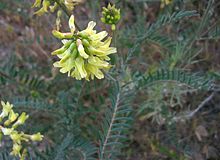| Astragalus trichopodus | |
|---|---|

| |
| Conservation status | |
 Vulnerable (NatureServe) | |
| Scientific classification | |
| Kingdom: | Plantae |
| Clade: | Tracheophytes |
| Clade: | Angiosperms |
| Clade: | Eudicots |
| Clade: | Rosids |
| Order: | Fabales |
| Family: | Fabaceae |
| Subfamily: | Faboideae |
| Genus: | Astragalus |
| Species: | A. trichopodus |
| Binomial name | |
| Astragalus trichopodus (Nutt.) A.Gray | |
Astragalus trichopodus is a species of legume known by the common name Santa Barbara milk vetch. It is native to southern California and Baja California, where it grows in several types of open habitat, including in the Transverse Ranges and Mojave Desert.
The species has three subspecies:
Astraglus trichopodus var. antiselli - Antisell's milkvetch
Astraglus trichopodus var. lonchus - Southern California milkvetch
Astraglus trichopodus var. trichopodus - Santa Barbara milkvetch
Description
This is a robust perennial herb producing a branching stem up to about a meter in maximum height. The hairy stem is lined with many leaves each up to 20 cm (7.9 in) long which are made up of several pairs of widely spaced lance-shaped leaflets each up to 2.5 cm (0.98 in) in length. The inflorescence is a raceme of up to 50 flowers which are cream colored and sometimes tinted with light purple. Each flower is 2 to 3 cm (0.79 to 1.18 in) long including its tubular base of sepals. The species' blooming period is from February to June.
The fruit is a laterally compressed, slightly inflated legume pod up to 4 to 5 cm (1.6 to 2.0 in) long which dries to a papery texture. The fruits hang in bunches where they develop from the inflorescence. Each pod contains many seeds.
Distribution and habitat
The plant is endemic and native to southern California and its range also extends to Baja California. It can be found in coastal sage scrub and grassland communities.
It is most commonly found in the months of March, April, and May.
Its conservation status is listed as G3, which means it is vulnerable.
Ecology
Astragalus trichopodus supports several different species of butterflies and is the host plant for the Reakirt's blue, the arrowhead blue, the marine blue, Queen Alexandra's sulphur, and the critically endangered Palos Verdes blue butterfly.
The species was once thought to be the only host plant for Palos Verdes blue butterflies, but larvae have since been found to feed on Acmispon glaber as well.
References
- Kartesz, J.T. (1994). "Astragalus trichopodus". NatureServe. Retrieved 14 April 2024.
- "Santa Barbara Milkvetch (Astragalus trichopodus)". iNaturalist Canada. Retrieved 2024-04-19.
- ^ "Astragalus trichopodus Calflora". www.calflora.org. Retrieved 2024-04-12.
- "Astragalus trichopodus-Santa Barbara Milkvetch". www.moosacreeknursery.com. Retrieved 2024-04-26.
- "Astragalus trichopodus (Nutt.) A.Gray". www.gbif.org. Retrieved 2024-04-19.
- "NatureServe Explorer 2.0". explorer.natureserve.org. Retrieved 2024-04-19.
- ^ Johnson, J., A. Stangeland, D. Amoroso, A. Romero, J. VanKempen, T. Wilson, S. Foster, T. Hampson, J. Eccles, K. Virun, R. Minzer, B. Coomes, J. Mauck, D. Flannery, B. MacQuiddy, M. McNeil, M. Wagner and T. Longcore, 2010. Final Report for Palos Verdes Blue Butterfly Year 2010 Captive Rearing on Defense Fuel Support Point, San Pedro, California and The Butterfly Project, Moorpark, California. Los Angeles: The Urban Wildlands Group (Defense Logistics Agency Agreement # N62473-08-LT-R0011). 22 pp.
External links
| Taxon identifiers | |
|---|---|
| Astragalus trichopodus |
|
| Phaca trichopoda | |
This Astragalus-related article is a stub. You can help Misplaced Pages by expanding it. |